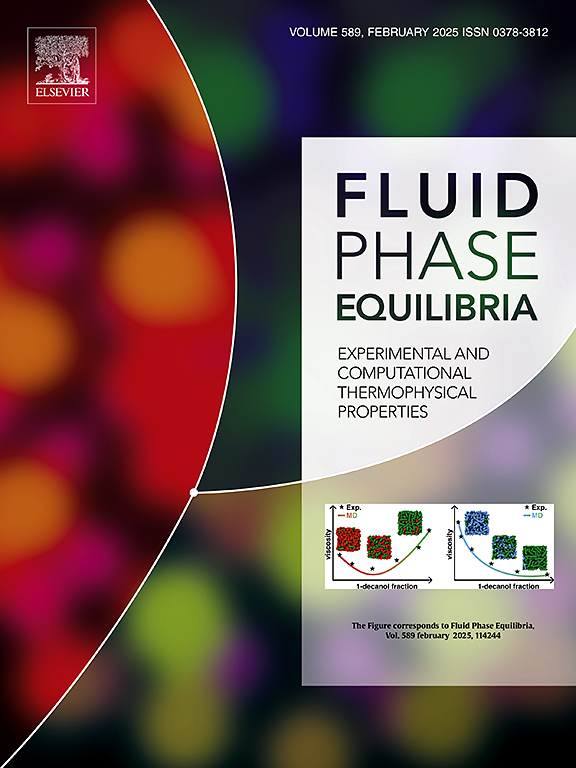Phase equilibrium measurements and thermodynamic modeling of CO2 + guaiacol, CO2 + guaiacol and ethanol, and CO2 + guaiacol, ethanol, and water
IF 2.8
3区 工程技术
Q3 CHEMISTRY, PHYSICAL
引用次数: 0
Abstract
This work reports phase equilibrium measurements for the systems CO2 + guaiacol, CO2 + guaiacol + ethanol, and CO2 + guaiacol + ethanol + water, which are related to the lignocellulosic biomass processing with supercritical CO2 as solvent. Measurements at constant compositions were carried out in a high-pressure variable-volume view cell at temperatures ranging from 303 to 343 K. CO2 molar fraction ranged from 0.3989 to 0.9695 in the CO2 + guaiacol system, from 0.5024 to 0.8492 for the CO2 + guaiacol + ethanol system, at three different ethanol to guaiacol molar ratios (1:1, 2:1 and 3:1), and from 0.4084 to 0.8997 for CO2 + guaiacol + ethanol + water, at a fixed ratio guaiacol:ethanol:water (1:3:1). Under these conditions, vapor-liquid (VL), liquid-liquid (LL), and vapor-liquid-liquid (VLL) phase transitions were detected depending on the system and composition evaluated, where bubble point (BP) and dew point (DP) transitions were observed. In the ternary system, the presence of ethanol as a cosolvent led to a decrease in the phase transition pressure compared to the binary system. Conversely, in the quaternary system, the inclusion of water resulted in an increase in the transition pressures compared to the ternary system due to the hydrophobic interaction between CO2 and water. The experimental data were modeled using Peng-Robinson equation of state and the quadratic van der Waals mixing rule (vdW2), and this applied thermodynamic model was capable of correlating and describing the phase behavior of these systems satisfactorily. The findings of this study are crucial for understanding and determining the phase behavior of systems involving CO2, guaiacol, ethanol, and water and can be helpful in the development of new processes for producing valuable compounds from lignocellulosic biomass.
求助全文
约1分钟内获得全文
求助全文
来源期刊

Fluid Phase Equilibria
工程技术-工程:化工
CiteScore
5.30
自引率
15.40%
发文量
223
审稿时长
53 days
期刊介绍:
Fluid Phase Equilibria publishes high-quality papers dealing with experimental, theoretical, and applied research related to equilibrium and transport properties of fluids, solids, and interfaces. Subjects of interest include physical/phase and chemical equilibria; equilibrium and nonequilibrium thermophysical properties; fundamental thermodynamic relations; and stability. The systems central to the journal include pure substances and mixtures of organic and inorganic materials, including polymers, biochemicals, and surfactants with sufficient characterization of composition and purity for the results to be reproduced. Alloys are of interest only when thermodynamic studies are included, purely material studies will not be considered. In all cases, authors are expected to provide physical or chemical interpretations of the results.
Experimental research can include measurements under all conditions of temperature, pressure, and composition, including critical and supercritical. Measurements are to be associated with systems and conditions of fundamental or applied interest, and may not be only a collection of routine data, such as physical property or solubility measurements at limited pressures and temperatures close to ambient, or surfactant studies focussed strictly on micellisation or micelle structure. Papers reporting common data must be accompanied by new physical insights and/or contemporary or new theory or techniques.
 求助内容:
求助内容: 应助结果提醒方式:
应助结果提醒方式:


